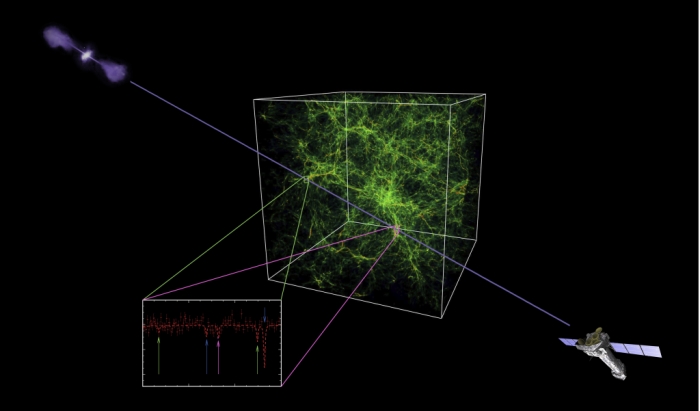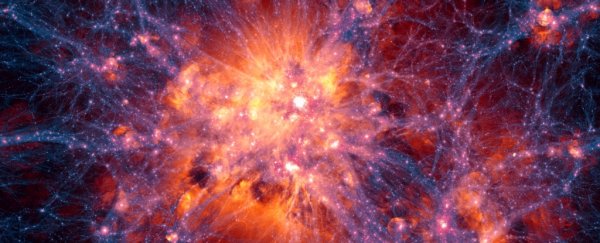Ordinary matter may only make up 5 percent of the mass of the Universe, but that doesn't necessarily mean we know where it all is. In fact, for 20 years, astronomers have been trying to figure out why there isn't as much as there should be.
Now an international team has put their heads together to solve the missing baryon problem, and found it, floating around in the space between the stars.
All the matter we can detect in the universe is made up of baryonic particles. The stars, the planets, nebulas, plasma, even black holes are all made of baryonic matter.
The total amount of baryonic matter - also known as normal or ordinary matter - in the Universe can be estimated based on analysis of the Cosmic Microwave Background, the background radiation left behind by the Big Bang.
Yet, according to the research team, only about two-thirds of this matter was accounted for - leaving a full third in The Land of Lost Socks, apparently.
"The missing baryons represent one of the biggest mysteries in modern astrophysics," said astronomer Fabrizio Nicastro of the INAF-Osservatorio Astronomico di Roma in Italy and the Harvard-Smithsonian Centre for Astrophysics.
"We know this matter must be out there, we see it in the early Universe, but then we can no longer get hold of it. Where did it go?"
According to a 2012 census of the Universe's baryons, around 10 percent of the baryons can be found inside galaxies, and a further 50 to 60 percent can be found in clouds of gas between galaxies, and in the regions of hot gas surrounding galaxies known as the circumgalactic medium.
(A study released earlier this year proposed that the missing baryons might be in the circumgalactic medium, but the researchers came up with bupkis.)
That still leaves between 30 and 40 percent short. But there's a very tricky place it's been predicted - the warm-hot intergalactic medium (WHIM). This is a web of hot, diffuse gas between the galaxies, thought to be leftover after their formation.
"This is where nature has become very perverse," said astrophysicist Michael Shull of the University of Colorado Boulder. "This intergalactic medium contains filaments of gas at temperatures from a few thousand degrees to a few million degrees."
Because it's so diffuse, it's very hard to see - practically invisible.
Unless you can backlight it, which is what the researchers did. They found a quasar called 1ES 1553, a galaxy with a very active black hole at its core. Quasars are some of the brightest objects in the Universe.
 (ESA/ATG medialab/XMM-Newton/Nicastro et al. 2018/R. Cen)
(ESA/ATG medialab/XMM-Newton/Nicastro et al. 2018/R. Cen)
This light can be used to illuminate whatever lies between us and it - and in this case, it was a filament of the WHIM.
Between 2015 and 2017, the research team used the ESA's space-based XMM-Newton X-ray observatory to observe 1ES 1553 for a total of 18 days.
"After combing through the data, we succeeded at finding the signature of oxygen in the hot intergalactic gas between us and the distant quasar, at two different locations along the line of sight," Fabrizio said.
"This is happening because there are huge reservoirs of material - including oxygen - lying there, and just in the amount we were expecting, so we finally can close the gap in the baryon budget of the Universe."
The gas that makes up the WHIM is actually predominantly ionised hydrogen, which has no electrons to produce spectral features. But heavier ionised oxygen does have a few electrons - which means it can be detected, so the researchers used that to infer the remaining mass.
From here, Fabrizio and his team plan to use other quasars to confirm their findings.
It's also an amazing start to a whole new way to study the WHIM, and by using other quasars, other teams of astronomers may be able to start putting together a map of its distribution, temperature and contents.
Another mystery is how it formed in the first place. But we may need to wait for the ESA's powerful Athena telescope, planned for a 2028 launch, for answers.
"The discovery of the missing baryons with XMM-Newton is the exciting first step to fully characterise the circumstances and structures in which these baryons are found," said astrophysicist Jelle Kaastra from the Netherlands Institute for Space Research.
"For the next steps, we will need the much higher sensitivity of Athena, which has the study of the warm-hot intergalactic medium as one of its main goals, to improve our understanding of how structures grow in the history of the Universe."
The research has been published in the journal Nature.
